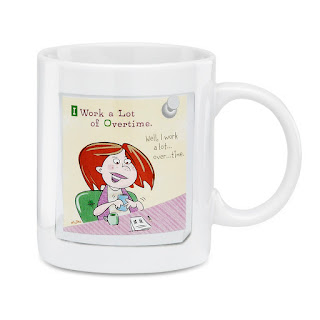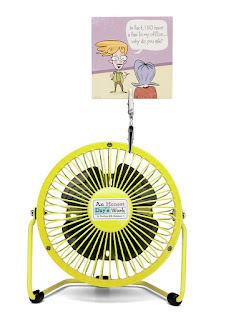How is it that you came to be an illustrator/artist?
I’ve doodled and drawn funny pictures as long as I can remember...mainly to make friends at school laugh or to get the attention of girls. However, because I grew up in a creative community of songwriters and musicians in the suburbs of Nashville, my first efforts creatively were more as a writer than as an artist or cartoonist. In the early 80’s, I cowrote a song that appeared on a T.G. Sheppard album that helped pay for some of my college tuition.
After I graduated and got married, I accidentally fell into a career as an auto insurance claims adjuster (Nobody goes into insurance on purpose, do they?) and quickly realized that I had to fight my way back from the dark side and do something creative.
Not long after that, I saw an opportunity to transfer to the insurance company’s branch in Colorado Springs, knowing that it just so happened to be right next door to Current Inc., a greeting card company I had my eye on. I naively devised this scheme wherein, once I was living the same town, I would overwhelm them with my creative abilities and slide right into a job there. Amazingly enough, I did get a position at Current--not because I impressed them, but because the editorial manager took pity on me. And when I finally did get in their doors, it was as a writer and not as a humorous illustrator, as I had expected.
 After leaving Current and spending a few years freelancing, I landed with Leanin’ Tree, another great card company located in Boulder, Colorado. I started off as a verse writer, taking on product management responsibilities as time went along. As Leanin’ Tree’s product director, I had the privilege of working closely with many talented artists and designers over a 10 year period. Getting the exposure to all their wonderful art and being able to participate in the product development of the card and gift product lines was personally very helpful and inspiring to me as I considered what I needed to do to improve my own art.
After leaving Current and spending a few years freelancing, I landed with Leanin’ Tree, another great card company located in Boulder, Colorado. I started off as a verse writer, taking on product management responsibilities as time went along. As Leanin’ Tree’s product director, I had the privilege of working closely with many talented artists and designers over a 10 year period. Getting the exposure to all their wonderful art and being able to participate in the product development of the card and gift product lines was personally very helpful and inspiring to me as I considered what I needed to do to improve my own art.
Recently, I restructured my job with Leanin’ Tree such that I am now able to work from home all but one day a week as a full-time writer. I had to give up my management role as product director to do that, but I hope it will pay off as I attempt to capitalize on the efficiencies gained from working at home and redirect them to a more focused effort towards building up my art licensing business.
The funny thing is that, even with all that experience working with artists as a product director for a manufacturer, I still feel very much like a novice when developing and promoting my own art to others. Being on the opposite side of the aisle has been eye opening for me. I’ve had some commercial successes, but I’ve made my share of mistakes, as well.
Who were your creative influences?
When just a teenager in Nashville during the 1970’s, I was extremely blessed to have a talented songwriter take me under his wing and serve as my creative mentor. He taught me a lot about creativity in general, writing in particular, and the importance of being able to step back and view your own work with a cold eye so that you could see and fix your flaws before anyone else had to point them out to you. It was my good fortune to tag along with him to recording sessions, songwriter gatherings, and pitch meetings where he had to play his songs to the “suits” at the publishing house before they would give him studio time for demos that would be sent to the country music stars of the day. More than anything else, he convinced me that I had the talent to build a creative career for myself...and I’ll always be in his debt for that.
Additionally, my best friend who I first met when I was only 10 years old, was the son of a successful songwriter and music publisher. Growing up, I probably spent more time in his house than I did my own, and in the process, I got to meet country music giants like Willie Nelson, Charlie Walker, Tanya Tucker, and Merle Haggard, just to name a few. Being able to listen in on the conversations these creative giants had amongst themselves about their craft was invaluable to me as a young man. Not surprisingly, my friend went on to be just as successful of a songwriter as his father had been.
The experiences I had in Nashville with these wonderfully creative and generous people probably gave me the courage and initiative to refocus my career when I got off track early on by taking a “safe” job with an insurance company as a newly wed.
When talking about artists in particular, I would say that my two greatest influences are Charles Schulz and Bill Watterson. “Peanuts” and “Calvin & Hobbs” were, in my estimation, the two best drawn AND written comics of my lifetime. One Christmas, my wife gave me the complete Calvin & Hobbs collection in hardback, which I now keep bedside to look at just before drifting off. (I’m hoping Watterson’s genius will somehow seep into my mind by osmosis.)
Early on, I thought writing and illustrating a daily strip would be the ideal job for me. However, as I got into my college years, it became painfully apparent that the newspaper industry was in decline, and many papers and strips were folding. As much as I loved that medium, I felt I would have to look elsewhere for my career.
What inspires you now?
Children’s books, editorial cartoons, and greeting cards are a big source of inspiration to me--along with the work of the artists that I have come to know over the years in the card and gift industry. Even though my current job responsibilities at Leanin’ Tree no longer require me to officially review all of the art that comes in, I look at it at every chance I get. And speaking of greeting cards, how great is it that while doing your grocery shopping, you can pause for a few minutes and enjoy the work of hundreds of talented artists and writers within a span of twenty feet or so?!
With the aforementioned demise of the daily newspaper and the shrinking space allotted to comics in the newspapers that do still exist, greeting cards are one of the modern refuges for humorous illustrators like me.
How do you work?
My illustrations are done 100% on the computer using a Wacom tablet, Corel Painter and Photoshop. While I have friends who do their sketching and inking on paper before scanning their work in to add color and put on the finishing touches, I decided to force myself to become comfortable doing the whole process digitally, from beginning to end. I will probably take on Illustrator at some point in the near future, but I don’t presently use it.
My reasons for doing everything on the computer have less to do with artistic concerns and more to do with lifestyle choices. Whether it’s a mid-life crises or a second childhood, now in my 50’s I have belatedly taken up snowboarding and surfing. The former can be done within hours of my home studio. The latter requires some travel. As long as I have a laptop, a small digital drawing tablet, and an internet connection, I’m in business even while in the jungles and coastlines of Central America.
Are There links where people can find more work or products with your images?
An Honest Day's Work Calendar by TF Publishing: http://www.tfpublishing.com/collections/frontpage/products/2013-an-honest-days-work
(4 JPEGs showing front, back and an inside spread provided in this email.)
An Honest Day's Work gift product by Pavilion Gift (all products): http://www.paviliongift.com/main/src/main.asp?z=ProductBrowse&category_id=282
(Separate email with additional gift product images to come.)
What types of markets do you do art/illustration for?
 Since I can illustrate AND write, I like to think I provide an extra service to the card companies that many artists can’t offer. And even where gift products are concerned, most of my contract work has required both skills.
Since I can illustrate AND write, I like to think I provide an extra service to the card companies that many artists can’t offer. And even where gift products are concerned, most of my contract work has required both skills.
Not that you asked, but the most bizarre thing that I’ve licensed my art for would have to be the coworker and boss voodoo dolls I was asked to design. (Please do not ask me to divulge my inspirations for this particular product line.)
What other creative interests do you have?
I am still interested in songwriting, but do not pursue it commercially. I’ve had political cartoons published in smaller papers that have won national recognition in the past, but I decided a while back not to focus my time there as I found it caused me to become more jaded and cynical than I already am. Chuck Asay, the political cartoonist for the Colorado Springs Gazette until he retired in 2007 told me that I was too nice to be an editorial cartoonist. I think that was one of the nicest rejections I ever got!
 I have some interest in trying stand-up comedy...might be a goal for 2013. For the most part, I like writing funny stuff, but not necessarily performing it, so that would push me out of my comfort zone--the primary reason for doing it, I suppose.
I have some interest in trying stand-up comedy...might be a goal for 2013. For the most part, I like writing funny stuff, but not necessarily performing it, so that would push me out of my comfort zone--the primary reason for doing it, I suppose.
I’ve considered writing movie transcripts, but writing short greeting card verse for so long has only served to hasten the dwindling of my attention span, so anything beyond a four-line rhyme feels like a major undertaking now.
What is the thing you love best about what you do?
I love greeting cards. I always have. I think they are incredibly priced treasures of great art and writing. I probably send less than 50% of the cards I buy. Before Twitter taught us to compress our thoughts into 140 characters or less, greeting cards were showing us that much could be communicated with a small number of words. And knowing that a card I wrote or illustrated has made someone smile--even for a small moment--means a great deal to me. Our lives are really just a long thread made up of tiny moments. And if you don’t think that tiny increments of time matter, just ask the athlete who missed a gold medal by 100th of a second. In the new millennium, I think that little is the new big.



































